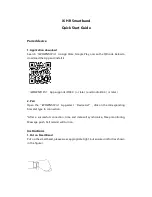
FAQs (Frequently Asked Questions)
uses an active element (TFT) to control each individual pixel and the refresh rate is
therefore not really applicable to LCD technology.
Q:
Will the LCD screen be resistant to scratches?
A:
A protective coating is applied to the surface of the LCD, which is durable to a
certain extent (approximately up to the hardness of a 2H pencil). In general, it is
recommended that the panel surface is not subject to any excessive shocks or
scratches.
Q:
How should I clean the LCD surface?
A:
For normal cleaning, use a clean, soft cloth. For extensive cleaning, please use
isopropyl alcohol. Do not use other solvents such as ethyl alcohol, ethanol, acetone,
hexane, etc.
Q:
Can I change the color setting of my monitor?
A:
Yes, you can change your color setting through OSD control as the following
procedures,
1. Press "MENU" to show the OSD (On Screen Display) menu
2. Press "Arrow" to select the option "color" then press "MENU" to enter color setting,
there are five settings as below.
a. 6500K; this setting features the panel closed to red-white color tone.
b. 9300K; this setting features the panel closed to blue-white color tone.
c
. User Define; the user can choose his/her preference color setting by
adjusting red, green, blue color.
d. sRGB; this is a standard setting for ensuring correct exchange of
colors between different device (e.g. digital cameras, monitors, printers,
scanners, etc.)
*A measurement of the color of light radiated by an object while it is being heated. This measurement
is expressed in terms of absolute scale, (degrees Kelvin). Lower Kevin temperatures such as 2004K
are red; higher temperatures such as 9300K are blue. Neutral temperature is white, at 6504K.
Q:
Can the Philips LCD Monitor be mounted on the wall?
file:///I|/Q70G9002813 8B 191EW9/lcd/manual/ENGLISH/191EW9/safety/saf_faq.htm(第 3/6 页)2008-12-8 16:15:51






































